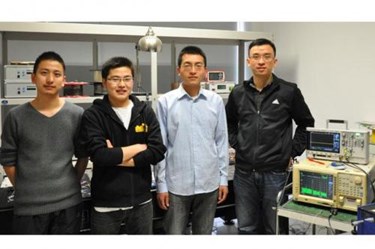High Power Laser Sources At Exotic Wavelengths

High power laser sources at exotic wavelengths may be a step closer as researchers in China report a fibre optic parametric oscillator with record breaking efficiency. The research team believe this could lead to new light sources for a range of biomedical imaging applications.
Mature commercial laser platforms are available for common output wavelengths. Some applications, however, require wavelengths that cannot readily be produced with established technologies. Several of these are in the field of biomedical imaging and spectroscopy (e.g. coherent anti-Stokes Raman scattering microscopy and optical coherence tomography). In such systems if the wavelength of light used can be optimised for the biological environment the performance can be greatly improved.
For fibre lasers the most commonly available outputs are around 1.06, 1.5 or 2.0 µm. Developing materials that can provide gain in less conventional wavelength bands is difficult and it is easier to employ conversion from the wavelength of a more conventional laser source.
Fibre optical parametric amplifiers (FOPAs) can convert optical energy from conventional wavelengths and a fibre optical parametric oscillator (FOPO) based on the gain from a FOPA can generate tuneable radiation. Theoretically, FOPAs could provide optical gain at nearly any wavelength and so FOPOs could emit laser beams in nearly any wavelength. However, low conversion efficiencies limit the usefulness of FOPOs as light sources.
The Tsinghua team attribute the high efficiency of their design to three factors. Firstly, large parametric gain provided by an optimized PCF, achieved through careful design of the dispersion and nonlinear properties of the fibre. The PCFs, fabricated and tested by FiberHome Telecommunication Technologies, were shown to be able to provide large gain in a very wide wavelength range. The second factor is walk-off effect, which has a critical influence on the optical gain. To minimize walk-off, they use a 'homemade' picosecond mode-locked fibre laser as the pump, instead of a femtosecond unit, giving a wider pulsewidth. The interaction length between the signal and the pump in the gain fibre is longer, so more of the pump energy can be converted to the signal wavelength.
The third key factor cited by the team is a concentration on minimising losses in the laser cavity by using an all fibre FOPO configuration, given a dramatic improvement in efficiency compared to their previously reported results. In their previous configuration a free-space optical time delay line was placed in the oscillator cavity to tune the cavity length, incurring a 4 dB loss. To avoid this, in the current work a specific length of optical fibre is used to adjust the cavity length.
Filling in the gaps
The team expect the first applications of their work will be in bio-medical imaging, as the radiation their design can produce is well matched with the requirements of emerging technologies in this area. However, to achieve high efficiency output across a wide wavelength range the cavity length needs to be tuneable. "In the FOPO configuration, the signal pulse needs to be synchronized with the pump pulse. So an optical cavity with adjustable length is preferred. In our experiment, the cavity length cannot be tuned, so at some wavelengths the signal cannot be tuned to synchronize with the pump. It is not a continuously tuned source. So it is important to develop an optical delay line with low loss at a wide wavelength regime." Said Zhang.
The team are now working to improve conversion efficiency in the signal and idler simultaneously by making a double-rings cavity FOPO that allows the signal and idler to oscillate simultaneously. They are also working to extend the output wavelength range. "Our research interests also focus on terahertz generation based on difference frequency generation from FOPO and terahertz parametric oscillators." said Zhang. "We think in the next decade, the operating wavelength of FOPOs can be extended to, for example, generate mid-infrared light and even terahertz. And the conversion efficiency will be higher. Eventually I think it will be possible to tune a FOPO in a wavelength region over 1000 nanometers."
Source: Institution of Engineering and Technology
